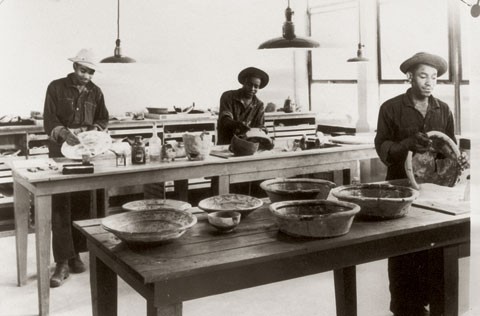
National Park Service technicians assembling ceramics recovered from Jamestown, Virginia, with some of the May-Hartwell collection in the foreground, 1938. (Courtesy, National Park Service, Colonial National Historical Park. Photo # 7030.)
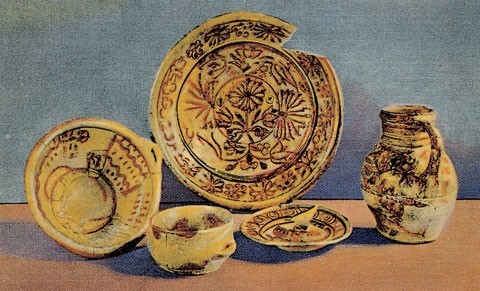
Postcard, ca. 1938. This early souvenir postcard from Jamestown illustrates sgraffito slipware vessels from the May-Hartwell ditch. (Private collection.)
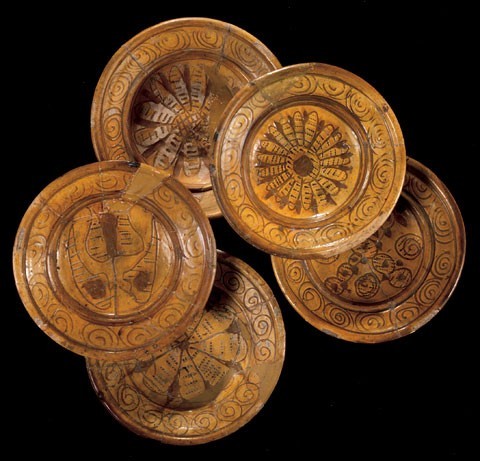
A collection of small plates from the May-Hartwell ditch. Sgraffito decorated with a variety of floral and geometric motifs. (Courtesy, National Park Service, Colonial National Historical Park; photo, Gavin Ashworth.) Clockwise from bottom: COLO J 7343; COLO J 7371; COLO J 7341; COLO J 7298; COLO J 7372.

Detail of map depicting the North Devon region in southwestern England. Sgraffito-decorated slipware was produced in the region from the seventeenth until the nineteenth centuries, most notably in Barnstaple and Bideford. (Chipstone Foundation.)
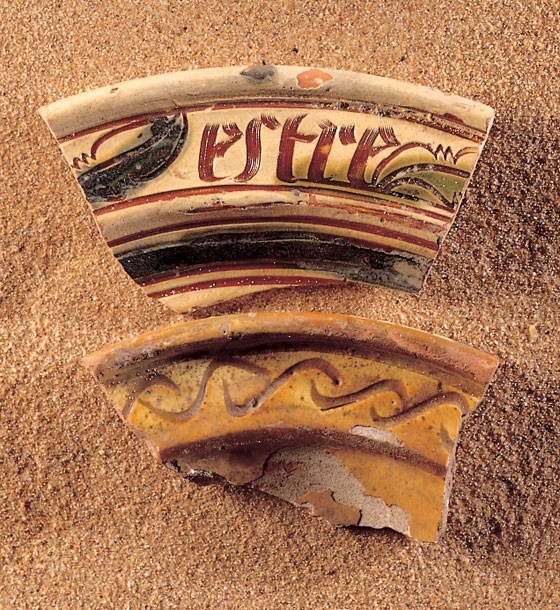
Sgraffito-decorated slipware dish fragments showing Continental influence on North Devon. Top: Beauvais, France, sixteenth century; bottom: North Devon, ca. 1620–1660. (Courtesy, Ivor Noël Hume.)
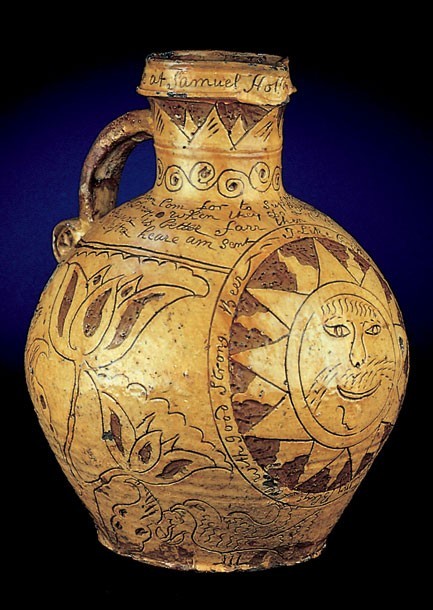
Harvest jug, North Devon, Barnstable, 1764. Sgraffito slipware. H. 14 1/2". (Courtesy, Colonial Williamsburg Foundation.) This highly ornamented vessel is typical of scratch-decorated forms produced in the eighteenth century and later.

Dish, North Devon, ca. 1620–1640. Sgraffito slipware. (Courtesy, Association for the Preservation of Virginia Antiquities; photo, Gavin Ashworth.) Excavated from the Richard Buck site near Jamestown, this example is decorated with an S-scroll rim device and a bird and leaf central motif. This decoration is commonly found on North Devon slipware from the second quarter of the seventeenth-century Virginia sites.
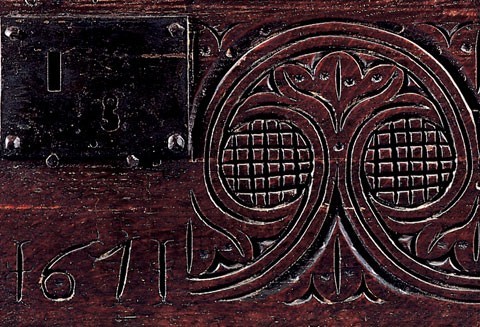
Detail of a carved box, England, 1671. Oak. H. 8 3/4", W. 26", D. 16 1/2". (Private collection; photo, Gavin Ashworth.) The stylized geometric and foliage decoration on this box are elements shared in other decorative arts of the period.
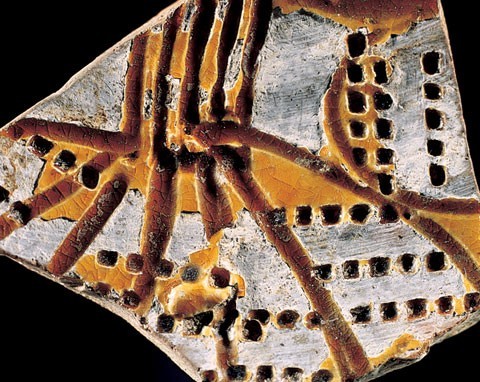
Detail of a North Devon sgraffito slipware fragment illustrating that the same multi-pointed tool was used to incise parallel lines and to punch patterns of indentations on individual vessels. In this case, the tool had five points or prongs. The glaze is missing in several areas on this example. (Courtesy, National Park Service, Colonial National Historical Park; photo, Gavin Ashworth.)
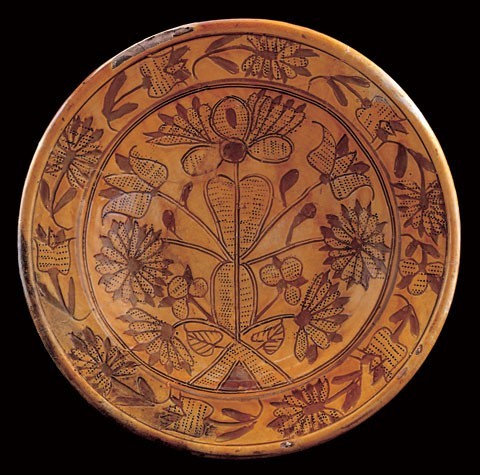
Dish, North Devon, ca. 1670–1680. Sgraffito slipware. D. 13". (Courtesy, National Park Service, Colonial National Historical Park; photo, Gavin Ashworth.) COLO J 7367.
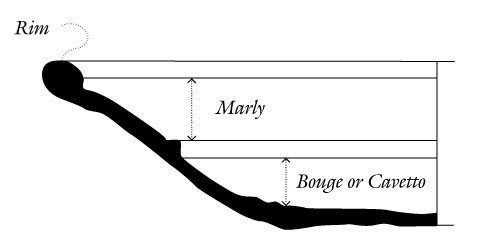
Section drawing depicting North Devon slipware dish and plate nomenclature.
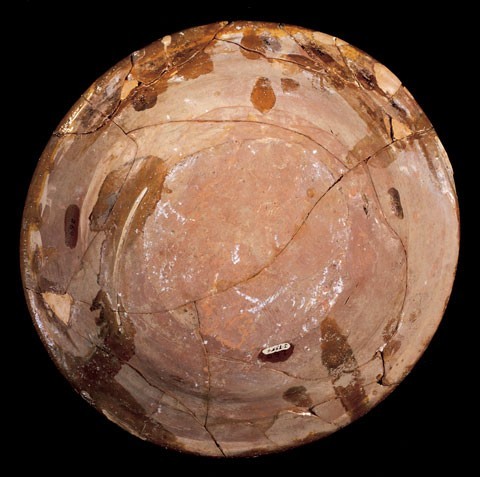
Reverse of dish, North Devon, ca. 1670–1680. Sgraffito slipware. D. 14". (Courtesy, National Park Service, Colonial National Historical Park; photo, Gavin Ashworth.) COLO J 7354. Note the knife trimming on walls above the base, and the numerous drips of slip and glaze indicating the importance of production speed.

Dish, North Devon, ca. 1670–1680. Sgraffito slipware. D. 12 1/2". (Courtesy, National Park Service, Colonial National Historical Park; photo, Gavin Ashworth.) COLO J 7339. This dish is decorated with an elaborate floral motif on the marly and in the center.
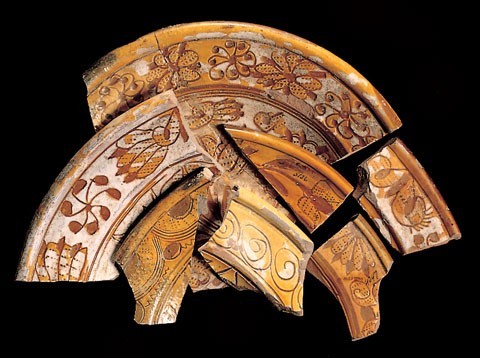
Dish fragments displaying a variety of marly decorations, North Devon, ca. 1670–1680. Sgraffito slipware. (Courtesy, National Park Service, Colonial National Historical Park; photo, Gavin Ashworth.) Bottom to top, left to right: COLO J 53725; COLO J 53639; COLO J 53707; COLO J 53794; COLO J 53797; COLO J 53570.
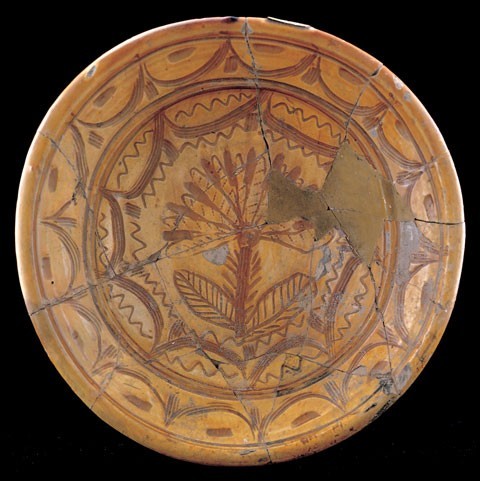
Dish, North Devon, ca. 1670–1680. Sgraffito slipware. D. 12". (Courtesy, National Park Service, Colonial National Historical Park; photo, Gavin Ashworth.) COLO J 7330. Note swag and tassel motif on marly.
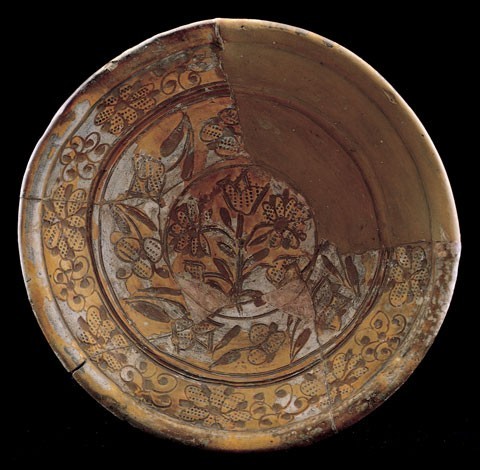
Dish, North Devon, ca. 1670–1680. Sgraffito slipware. D. 12 1/2". (Courtesy, National Park Service, Colonial National Historical Park; photo, Gavin Ashworth.) COLO J 7581. A floral spray on the bouge encircles the small floral medallion in the center of this dish.
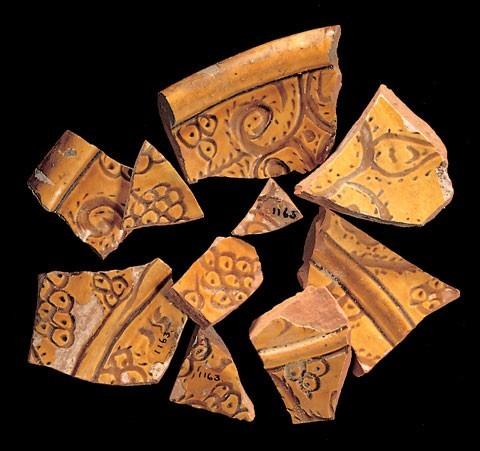
Dish fragments inscribed with grape clusters, North Devon, ca. 1670–1680. Sgraffito slipware. (Courtesy, National Park Service, Colonial National Historical Park; photo, Gavin Ashworth.) COLO J53475; COLO J 53481; COLO J 53495.
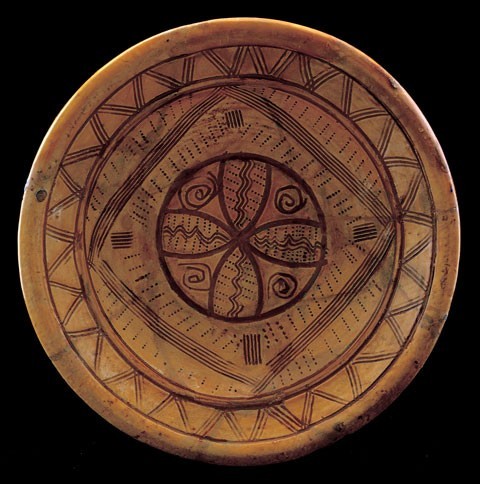
Dish, North Devon, ca. 1670–1680. Sgraffito slipware. D. 11 1/2". (Courtesy, National Park Service, Colonial National Historical Park; photo, Gavin Ashworth.) COLO J 7336. This is the only marly decorated with a chevron motif. It resembles a dish with a cross-hatched design recovered from a ca. 1673 context during excavations at Colony of Avalon at Ferryland, Newfoundland.

Dish, North Devon, ca. 1670–1680. Sgraffito slipware. D. 14 3/4". (Courtesy, National Park Service, Colonial National Historical Park; photo, Gavin Ashworth.) COLO J 7348. This dish is centrally decorated with a stylized so-called “Chinese butterfly” motif.
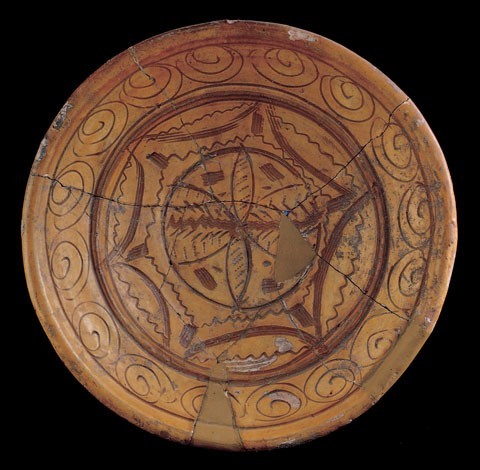
Dish, North Devon, ca. 1670–1680. Sgraffito slipware. D. 20". (Courtesy, National Park Service, Colonial National Historical Park; photo, Gavin Ashworth.) COLO J 7329. A compass was used to draw the six-pointed star in the center of this dish.
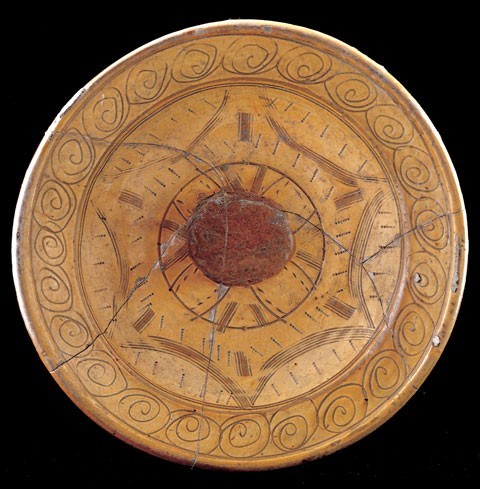
Dish, North Devon, ca. 1670–1680. Sgraffito slipware. D. 15". (Courtesy, National Park Service, Colonial National Historical Park; photo, Gavin Ashworth.) COLO J 7366. Pre-glost firing damage is displayed in the center of this plate
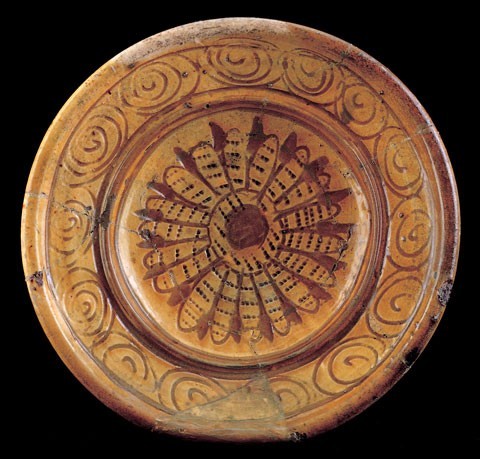
Plate, North Devon, ca. 1670–1680. Sgraffito slipware. D. 7 1/2". (Courtesy, National Park Service, Colonial National Historical Park; photo, Gavin Ashworth.) COLO J 7298.
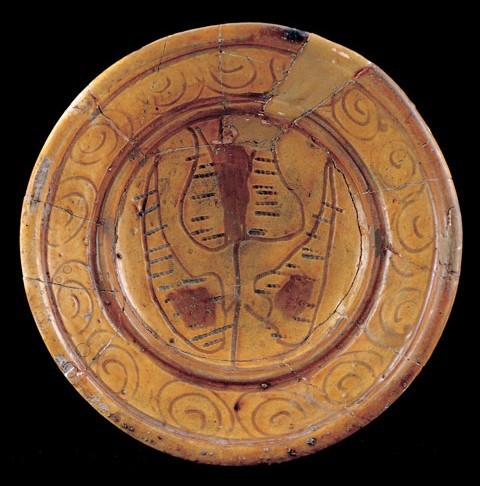
Plate, North Devon, ca. 1670–1680. Sgraffito slipware. D. 7 1/2". (Courtesy, National Park Service, Colonial National Historical Park; photo, Gavin Ashworth.) COLO J 7371.

Plate, North Devon, ca. 1670–1680. Sgraffito slipware. D. 7 1/2". (Courtesy, National Park Service, Colonial National Historical Park; photo, Gavin Ashworth.) COLO J 7372.

Plate with piecrust edge, North Devon, ca. 1670–1680. Sgraffito slipware. D. 9 1/2". (Courtesy, National Park Service, Colonial National Historical Park; photo, Gavin Ashworth.) COLO J 7353. Four large carnations with bisecting stems decorate this vessel.
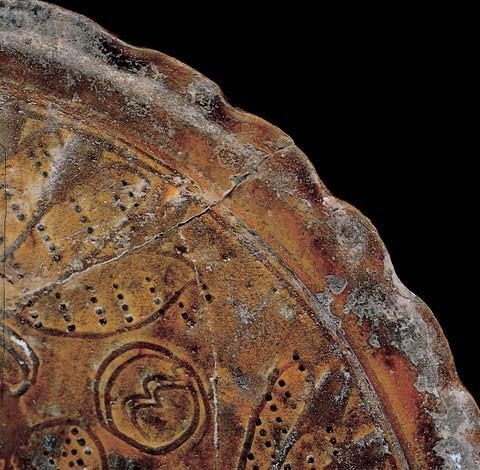
Detail of plate illustrated in fig. 25

Mug, North Devon, ca. 1670–1680. Sgraffito slipware. H. 3 3/4". (Courtesy, National Park Service, Colonial National Historical Park; photo, Gavin Ashworth.) COLO J 47307. This gorge-shaped mug is decorated with a floral motif.

Mug, North Devon, ca. 1670–1680. Sgraffito slipware. H. 3 3/4". (Courtesy, National Park Service, Colonial National Historical Park; photo, Gavin Ashworth.) COLO J 7534.
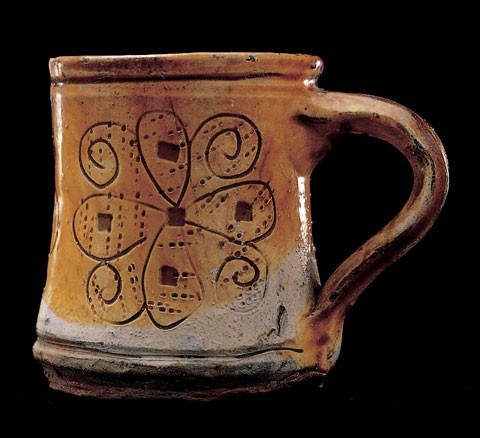
Mug, North Devon, ca. 1670–1680. Sgraffito slipware. H. 3 3/4". (Courtesy, National Park Service, Colonial National Historical Park; photo, Gavin Ashworth.) COLO J 7297. This stylized quatrefoil flower is found on many other hollow and flat forms.

Jug, North Devon, ca. 1670–1680. Sgraffito slipware. H. 6 3/4". (Courtesy, National Park Service, Colonial National Historical Park; photo, Gavin Ashworth.) COLO J 7346. A combination of wavy lines and multipetaled floral devices decorate this example.
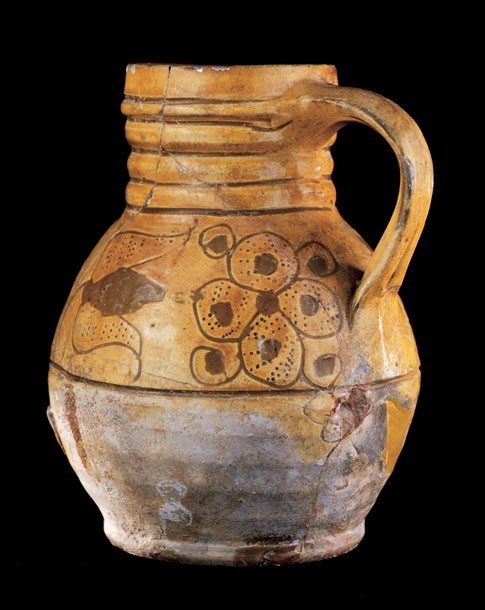
Jug, North Devon, ca. 1670–1680. Sgraffito slipware. H. 6 3/4". (Courtesy, National Park Service, Colonial National Historical Park; photo, Gavin Ashworth.) COLO J 7296. Quatrefoil flowers and tulips are incised on this jug.
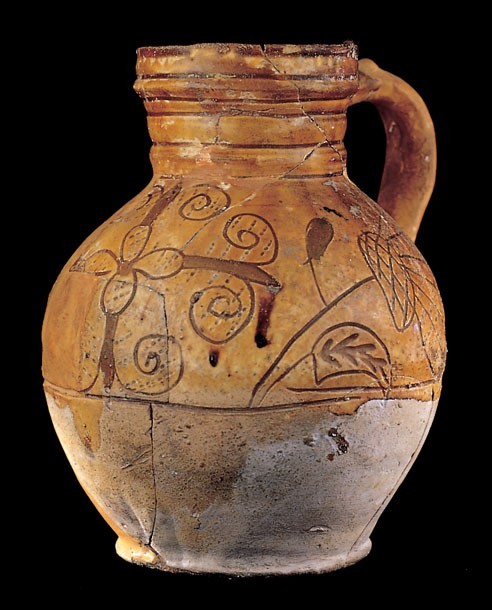
Jug, North Devon, ca. 1670–1680. Sgraffito slipware. H. 6 3/4". (Courtesy, National Park Service, Colonial National Historical Park; photo, Gavin Ashworth.) COLO J 7347. This jug is ornamented with a quatrefoil flower and carnations.
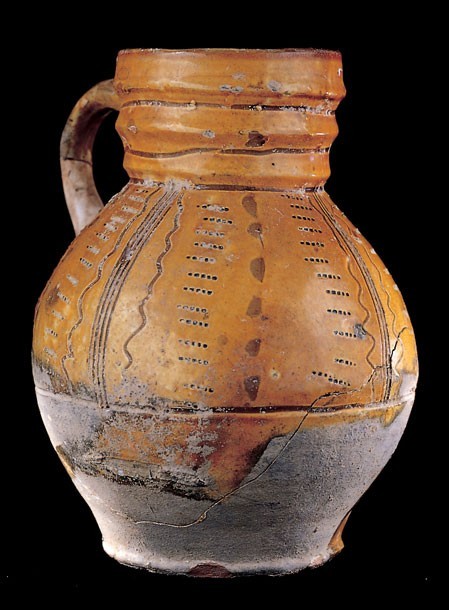
Jug, North Devon, ca. 1670–1680. Sgraffito slipware. H. 8 1/2". (Courtesy, National Park Service, Colonial National Historical Park; photo, Gavin Ashworth.) COLO J 7368.
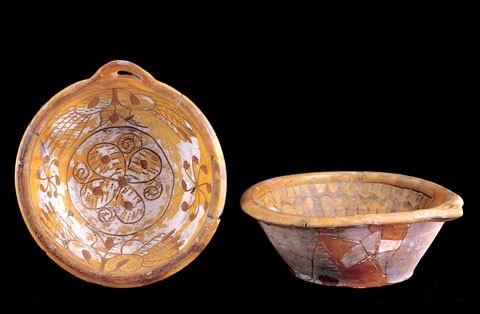
Bowls, North Devon, ca. 1670–1680. Sgraffito slipware. H. 4", D. 8 3/4". (Courtesy, National Park Service, Colonial National Historical Park; photo, Gavin Ashworth.) Left: COLO J 7352; right: COLO J 7344. Both have a single horizontal loop handle on the rim exterior, and are sgraffito-decorated on the interior

Chamber pot, North Devon, ca. 1670–1680. Sgraffito slipware. H. 5 1/2". (Courtesy, National Park Service, Colonial National Historical Park; photo, Gavin Ashworth.) COLO J 7369. The exterior of this chamber pot is decorated with chevrons, wavy lines, and dashes.
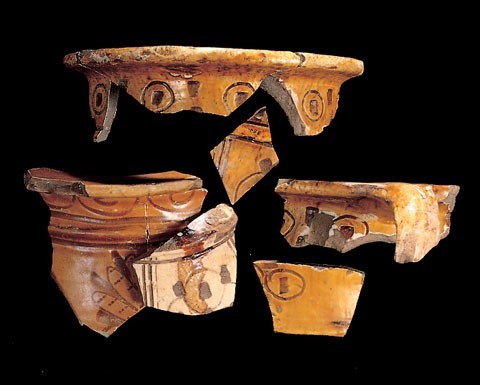
Fragments of two incomplete chamber pots, North Devon, ca. 1670–1680. Sgraffito slipware. (Courtesy, National Park Service, Colonial National Historical Park; photo, Gavin Ashworth). COLO J 53452; COLO J 53459; COLO J 53469; COLO J 53472; COLO J 53636.
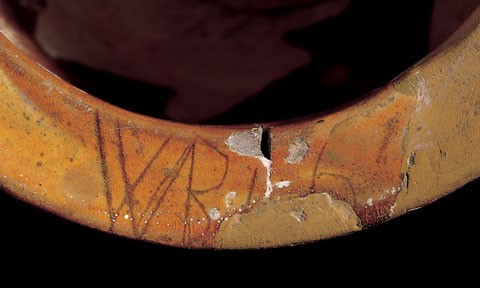
Detail of the rim of the chamber pot illustrated in figure 35. (Courtesy, National Park Service, Colonial National Historical Park; photo, Gavin Ashworth.) The initials are possibly those of William Berkeley, governor of Virginia during the period in which the pot was manufactured.

Candlestick, North Devon, ca. 1670–1680. Sgraffito slipware. H. 6 5/16". (Courtesy, National Park Service, Colonial National Historical Park) COLO J 12342. Because of its rarity, this is one of the most important ceramic objects in the archaeological collections of the National Park Service at Jamestown.
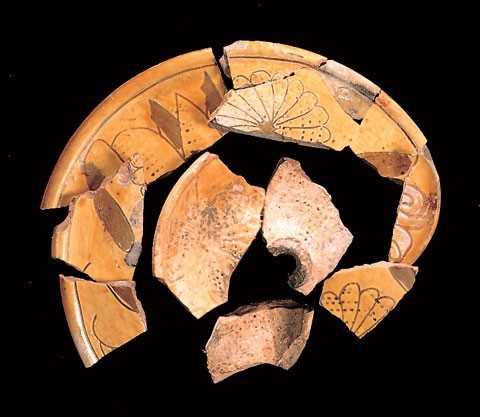
Fragments of incomplete candlestick, North Devon, ca. 1670–1680. Sgraffito slipware. (Courtesy, National Park Service, Colonial National Historical Park; photo, Gavin Ashworth.) COLO J 53453; COLO J 53454; COLO J 53460. This candlestick is decorated on all exterior surfaces with floral devices
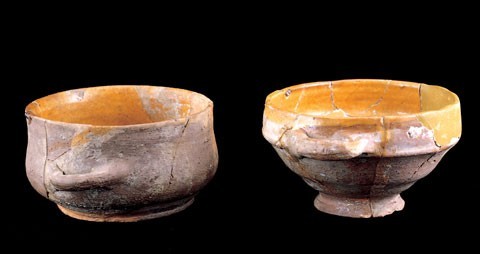
Porringers, North Devon, ca. 1670–1680. Slipware. Left: H. 3"; right: H. 3 1/4". (Courtesy, National Park Service, Colonial National Historical Park; photo, Gavin Ashworth.) Left: COLO J 7331; right: COLO J 7333. These examples represent the two porringer forms found.
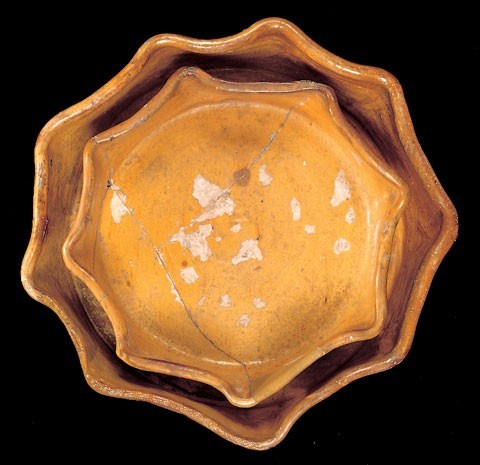
Dishes, North Devon, ca. 1670–1680. Slipware. D. 9", 10 1/2". (Courtesy, National Park Service, Colonial National Historical Park; photo, Gavin Ashworth.) Smaller: COLO J 7337; larger: COLO J 7300. These wavy edge dishes occur in graduated sizes.
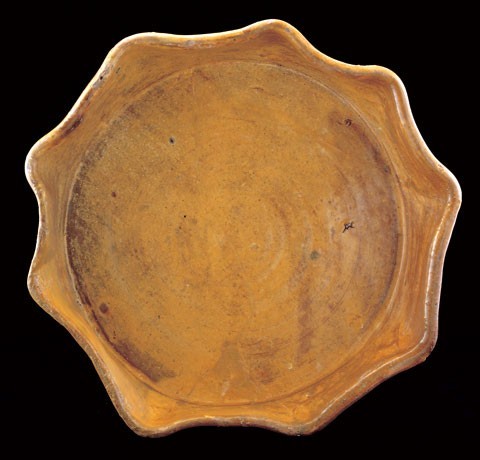
Dish, North Devon, ca. 1670–1680. Slipware. D. 9 1/2". (Courtesy, National Park Service, Colonial National Historical Park; photo, Gavin Ashworth.) COLO J 7340.
